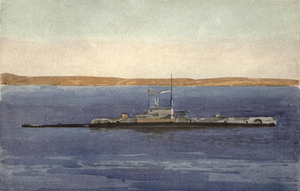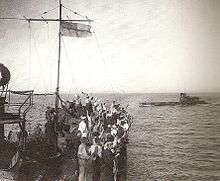HMS E11
 HMS E11 off the Dardanelles in 1915 | |
| History | |
|---|---|
| Name: | HMS E11 |
| Launched: | 23 April 1914 |
| Fate: | Sold for scrap, Malta, March 1921 |
| General characteristics | |
| Class and type: | E class submarine |
| Displacement: |
|
| Length: | 181 ft (55 m) |
| Beam: | 15 ft (4.6 m) |
| Propulsion: |
|
| Speed: |
|
| Range: |
|
| Complement: | 30 |
| Armament: |
|
HMS E11 was an E-class submarine of the Royal Navy launched on 23 April 1914. E11 was one of the most successful submarines in action during the 1915 naval operations in the Dardanelles Campaign, sinking over 80 vessels of all sizes in three tours of the Sea of Marmara.
Design
Like all post-E8 British E-class submarines, E11 had a displacement of 662 tonnes (730 short tons) at the surface and 807 tonnes (890 short tons) while submerged. She had a total length of 180 feet (55 m)[1] and a beam length of 22 feet 8.5 inches (6.922 m). She was powered by two 800 horsepower (600 kW) Vickers eight-cylinder two-stroke diesel engines and two 420 horsepower (310 kW) electric motors.[2][3] The submarine had a maximum surface speed of 16 knots (30 km/h; 18 mph) and a submerged speed of 10 knots (19 km/h; 12 mph). British E-class submarines had fuel capacities of 50 tonnes (55 short tons) of diesel and ranges of 3,255 miles (5,238 km; 2,829 nmi) when travelling at 10 knots (19 km/h; 12 mph).[1] E11 was capable of operating submerged for five hours when travelling at 5 knots (9.3 km/h; 5.8 mph).
E11 was initially armed with a single 6-pounder QF gun mounted forward of the conning tower, but this was later replaced by a 12-pounder QF. She had five 18 inches (460 mm) torpedo tubes, two in the bow, one either side amidships, and one in the stern; a total of 10 torpedoes were carried.[2]
E-Class submarines had wireless systems with 1 kilowatt (1.3 hp) power ratings; in some submarines, these were later upgraded to 3 kilowatts (4.0 hp) systems by removing a midship torpedo tube. Their maximum design depth was 100 feet (30 m) although in service some reached depths of below 200 feet (61 m). Some submarines contained Fessenden oscillator systems.[1]
Crew
Her complement was three officers and 28 men.[1]
Service history
European operations
In September 1914, Havmanden, a submarine of neutral Denmark displaying her pennant number of 3 on her conning tower, was mistaken for the German U-boat SM U-3 by E11. A launched torpedo from E11 that missed its mark spared Havmanden.[4]
In October 1914 E11, under the command of Lieutenant-Commander Martin Nasmith,[5] was dispatched to the Baltic Sea along with two other submarines, but was twice intercepted by German patrols, and forced to return to Harwich. During the Scarborough Raid in December 1914, the E11 attempted to intercept the German battlecruisers, but failed due to faulty torpedoes.
E11 took part in the Cuxhaven Raid, which culminated on 25 December 1914 in the attack by seven seaplanes from the aircraft tenders HMS Engadine, HMS Riviera, and HMS Empress (escorted by three cruisers and several destroyers of the Harwich Force) on Zeppelin sheds and other military targets near Cuxhaven. Four of the aircraft failed to regain their ships; three of them landed at the rendezvous point where E11 was waiting and were scuttled, the crews being taken on board.[6][7]
Mediterranean operations

In May 1915, still commanded by Nasmith, E11 arrived at the Dardanelles to join the submarine campaign in the Sea of Marmara. E11 was the second submarine to undertake a successful tour, following the E14 which had passed through the straits on 27 April.
The E11 passed through the Dardanelles on the night of 18 May. Surfacing off the town of Gallipoli, Nasmith captured a Turkish sailing vessel and lashed it to the conning tower to act as a disguise. However, this ruse failed to attract any targets, so after several days he abandoned it. Travelling up the Sea of Marmara, he sank a gunboat and several other small craft on 23 May. The following day, near the port of Rodosto (today Tekirdağ), E11 encountered the Turkish transport Nagara, laden with ammunition. Aboard the transport was an American journalist Raymond Swing, from the Chicago Daily News. Nasmith sank the ship after it was abandoned by the crew and passengers. Nasmith sank another transport and forced one aground before being driven away from the shore by some Turkish cavalry.
On 25 May 1915 E11 reached Constantinople, now Istanbul. Nasmith was searching for the German warships SMS Goeben and SMS Breslau, but when he surfaced at 12:40, he sighted the elderly transport Stamboul lying alongside the Tophane Arsenal. Nasmith's first torpedo ran in a circle and nearly struck the E11, however the second torpedo hit Stamboul. Under fire from shore-based artillery, E11 dived to make her escape. Caught in the strong Bosphorus current, E11 was out of control for 20 minutes until she settled on the bottom near the Maiden's Tower. Stamboul failed to sink, but was beached at Harem. E11's attack on Constantinople, the first by an enemy vessel in over 100 years, had an enormous impact on Turkish morale, causing a panic in the city and compelling Goeben to shift to a safer mooring.

E11 returned to the Bosphorus approaches on 27 May and sank more ships, but running short of torpedoes and with mounting mechanical problems, Nasmith headed home on 5 June. On his return passage through the Dardanelles he encountered another transport which, despite his vulnerable position and the poor state of the submarine, he attacked and sank with his final two torpedoes. Passing through the Narrows near Çanakkale, E11 snagged a moored mine. Nasmith had to tow the mine out of the straits before he was able to disentangle the submarine. On E11's first tour, eleven ships were sunk or disabled. For this successful tour Nasmith was awarded the Victoria Cross, the third submarine commander to receive the award during the Dardanelles Campaign.
E11 was on her second tour when, on 6 August it successfully torpedoed the Turkish torpedo cruiser Peyk-i Şevket, causing serious damage.[8] Two days later 8 August 1915 as a new British landing was underway at Suvla, E11 torpedoed the antiquated Turkish pre-dreadnought battleship Barbaros Hayreddin off Bulair at the northern entrance to the Dardanelles. The ship sank with the loss of 21 officers and 237 men.[9] Barbaros Hayreddin was one of two Ottoman battleships sunk during the campaign. Visiting Constantinople again, E11 sank a Black Sea collier Isfahan as it was preparing to unload — a significant blow as coal was the main fuel source and supplies were scarce. Moving into the Gulf of Izmir, on the night of 20 August, E11's first officer, Lieutenant Guy D'Oyly-Hughes, swam ashore and blew up a section of the Constantinople–Baghdad railway line, a feat for which he was awarded the Distinguished Service Cross (United Kingdom). Navigating Officer Lieutenant Robert Brown was also awarded the Distinguished Service Cross (United Kingdom). A reservist from the Merchant Navy, Brown had famously been born rounding the Cape Horn on the clipper John Gambles, the sister ship to the more famous Cutty Sark.
E11 made three tours of the Sea of Marmara and sank in total 27 steamers and 58 smaller vessels.
Footnotes
- 1 2 3 4 Innes McCartney; Tony Bryan (20 February 2013). British Submarines of World War I. Osprey Publishing. pp. 11–12. ISBN 978-1-4728-0035-0.
- 1 2 Akerman, P. (1989). Encyclopaedia of British submarines 1901–1955. p.150. Maritime Books. ISBN 1-904381-05-7
- ↑ "E Class". Chatham Submarines. Retrieved 20 August 2015.
- ↑ Compton-Hall, Richard (2004) [1991]. Submarines at War, 1914–18. Penzance: Periscope Publishing. p. 140. ISBN 978-1-904381-21-1. OCLC 57639764.
- ↑ He would go on to command A/S forces in Western Approaches during the Second World War.
- ↑ Barnes & James, p.98.
- ↑ The rescued pilots were Flight Lieutenant Arnold John Miley (aircraft serial no. 120), Flight Sub-Lieutenant Vivian Gaskell Blackburn (aircraft serial no. 814) and Flight Commander Douglas Austin Oliver (aircraft serial no. 815).
- ↑ Langensiepen & Güleryüz, pp. 38–39
- ↑ Langensiepen & Güleryüz, p. 28
Bibliography
- Barnes C.H. & James D.N. Shorts Aircraft since 1900. London (1989): Putnam. p. 560. ISBN 0-85177-819-4.
- Langensiepen, Bernd & Güleryüz, Ahmet (1995). The Ottoman Steam Navy 1828–1923. London: Conway Maritime Press. ISBN 978-0-85177-610-1.